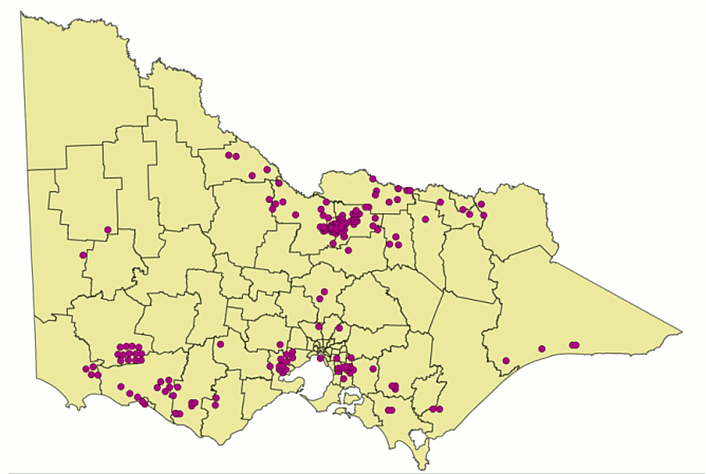Anthrax – Biosecurity advisory

Date of issue: 3 January 2018
You play an essential role in early diagnosis of anthrax
Victorian veterinary practitioners are reminded to consider anthrax when investigating sudden death or disease incidents in susceptible livestock.
- Anthrax is an infectious bacterial disease of animals, caused by the spore-forming bacterium Bacillus anthracis.
- There have been anthrax outbreaks near Swan Hill in the last few years and anthrax occurs sporadically in the Goulburn Valley.
- The disease usually appears during the warmer months however cases of anthrax may occur at any time of year and in locations where the disease may not have been recognised for many years.
If livestock dies suddenly, even when there is no history of anthrax on the property, anthrax could potentially be the cause.
Actions to take if you suspect anthrax
It is essential that, if livestock die suddenly and without an obvious cause:
- You report the incident immediately to Agriculture Victoria,
- The carcass is not moved, and
- The carcass is tested for anthrax by you or Agriculture Victoria Animal Health and Welfare (AHW) staff.
By following these steps or ensuring they occur, you will lower the risk of a large-scale anthrax incident.
How to report a suspect anthrax case to Agriculture Victoria
If you suspect an animal may have died from anthrax, immediately contact your local Agriculture Victoria AHW staff or call the Customer Call Centre on 136 186.
If you cannot speak directly with an officer from Animal Health and Welfare do not leave a message.
Instead, immediately ring the all-hours Emergency Animal Disease Hotline on 1800 675 888.
Funding of testing for anthrax by private veterinary practitioners
Anthrax exclusion testing should be carried out on all cases of sudden, unexplained death in cattle, sheep and other susceptible livestock.
Field testing of cattle and sheep carcasses can be carried out by private veterinary practitioners using an immunochromatographic test (ICT). Your local Agriculture Victoria AHW staff can provide you with the training you need to use the ICT kits (see below).
To encourage anthrax exclusion testing, particularly in areas of Victoria with a history of anthrax, Agriculture Victoria will pay private practitioners for a basic anthrax exclusion in cattle or sheep. To be eligible for this payment, a practitioner must notify Agriculture Victoria of the suspect case, perform an ICT and report the summary findings to the local Agriculture Victoria District Veterinary Officer (DVO) using a Record of Disease Event form. Your DVO will advise you during the investigation whether further samples are required and the appropriate method for dispatch of samples.
For more details on this funding please see our VetSource page.
ICT kits and training for private veterinary practitioners
Agriculture Victoria can provide training to any veterinarians in your practice on use of the kits and will provide ICT kits to your practice at no cost.
Please contact your local Agriculture Victoria AHW staff if you need more ICT kits or to organise refresher training of existing users or training for new ICT kit users.
What are the clinical signs of anthrax?
The clinical signs seen with anthrax vary depending on species. The disease can be peracute, acute, subacute and rarely, a more chronic form is seen.
Cattle, sheep and goats with anthrax typically have the peracute form and die suddenly. Just prior to death, animals may show signs of high fever although this is usually only noticed in animals that are frequently handled and where observation is more intense.
Blood may be present around the nose, mouth and anus of carcasses. However, in many cases you may not see this sign, so it should not be relied upon to diagnose anthrax.
Where does anthrax occur in Victoria?
In recent decades, most cases of anthrax in Victoria have been in northern or north eastern parts of the state and have involved cattle. Usually only a small number of deaths occur on each affected farm.
More recently cases have been seen in the north western part of the state. The most recent anthrax outbreak in Victoria were in sheep during 2017 to 2019 on properties near Swan Hill.
In the past anthrax has also been known to occur in Gippsland and in south western Victoria.
Anthrax could occur in locations where the disease may not have been recognised for many years or in locations where there is no recorded history of anthrax.
Anthrax cases in Victoria 1914 to 2009

Anthrax occurrences in Victoria, 1914 to 2009.
When does anthrax occur in Victoria?
Anthrax usually appears during the warmer months. However cases of anthrax have occurred, and may occur, at any time of year so continued vigilance is required.
More information
- Standard operating procedures: Testing for anthrax by private veterinarians using the hand-held immunochromatographic test (ICT). Available from your local Agriculture Victoria AHW staff.
- Fact sheet: Investigating suspected anthrax in the field using the hand-held ICT. Available from your local Agriculture Victoria AHW staff.
- Anthrax in animals
- VetSource
- Significant disease investigation program.
Online anthrax training for veterinarians
A series of short Anthrax Training Modules are now available online through the Agriculture Victoria Learning Management System (LMS).
The anthrax training modules have been designed as a series of three online learning modules.
The modules cover topics such as:
- general anthrax disease information
- when and how to use an ICT kit
- how to apply for and use anthrax vaccine
- safety considerations
- roles and responsibilities of Agriculture Victoria and private vets
- other useful information to support you.
It is recommended you complete the training every two years (as a minimum), however individual modules can be accessed anytime to provide you with a quick refresher whenever or wherever you need it.
Note: You must register as a ‘veterinarian’ or ‘veterinary student’ to access the modules.